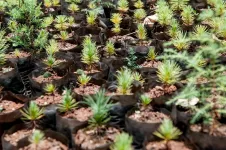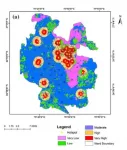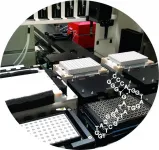A general approach to high-efficiency perovskite solar cells
2021-03-26
(Press-News.org) Perovskites, a class of materials first reported in the early 19th century, were "re-discovered" in 2009 as a possible candidate for power generation via their use in solar cells. Since then, they have taken the photovoltaic (PV) research community by storm, reaching new record efficiencies at an unprecedented pace. This improvement has been so rapid that by 2021, barely more than a decade of research later, they are already achieving performance similar to conventional silicon devices. What makes perovskites especially promising is the manner in which they can be created. Where silicon-based devices are heavy and require high temperatures for fabrication, perovskite devices can be lightweight and formed with minimal energy investiture. It is this combination - high performance and facile fabrication - which has excited the research community.
As the performance of perovskite photovoltaics rocketed upward, left behind were some of the supporting developments needed to make a commercially viable technology. One issue that continues to plague perovskite development is device reproducibility. While some PV devices can be made with the desired level of performance, others made in the exact same manner often have significantly lower efficiencies, puzzling and frustrating the research community.
Recently, researchers from the Emerging Electronic Technologies Group of Prof. Yana Vaynzof have identified that fundamental processes that occur during the perovskite film formation strongly influence the reproducibility of the photovoltaic devices. When depositing the perovskite layer from solution, an antisolvent is dripped onto the perovskite solution to trigger its crystallization. "We found that the duration for which the perovskite was exposed to the antisolvent had a dramatic impact on the final device performance, a variable which had, until now, gone unnoticed in the field." says Dr. Alexander Taylor, a postdoctoral research associate in the Vaynzof group and the first author on the study. "This is related to the fact that certain antisolvents may at least partly dissolve the precursors of the perovskite layer, thus altering its final composition. Additionally, the miscibility of antisolvents with the perovskite solution solvents influences their efficacy in triggering crystallization."
These results reveal that, as researchers fabricate their PV devices, differences in this antisolvent step could cause the observed irreproducibility in performance. Going further, the authors tested a wide range of potential antisolvents, and showed that by controlling for these phenomena, they could obtain cutting-edge performance from nearly every candidate tested. "By identifying the key antisolvent characteristics that influence the quality of the perovskite active layers, we are also able to predict the optimal processing for new antisolvents, thus eliminating the need for the tedious trial-and-error optimization so common in the field." adds Dr. Fabian Paulus, leader of the Transport in Hybrid Materials Group at cfaed and a contributor to the study.
"Another important aspect of our study is the fact that we demonstrate how an optimal application of an antisolvent can significantly widen the processibility window of perovskite photovoltaic devices" notes Prof. Vaynzof, who led the work. "Our results offer the perovskite research community valuable insights necessary for the advancement of this promising technology into a commercial product."
INFORMATION:
The results were published in the prestigious journal Nature Communications.
A general approach to high-efficiency perovskite solar cells by any antisolvent
Alexander D. Taylor, Qing Sun, Katelyn P. Goetz, Qingzhi An, Tim Schramm, Yvonne Hofstetter, Maximillian Litterst, Fabian Paulus & Yana Vaynzof
Nature Communications 2021, 12, 1878, DOI: 10.1038/s41467-021-22049-8
https://www.nature.com/articles/s41467-021-22049-8
[Attachments] See images for this press release:

ELSE PRESS RELEASES FROM THIS DATE:
2021-03-26
New study led by the University of Helsinki supports the recognition of new species of South American owls, two of them, Xingu Screech Owl and Alagoas Screech Owl, described for the first time.
In early 2021 two new species of screech owls are being described in a single publication as new to science. A multinational team involving researchers from the University of Helsinki, Brazil, and the USA published a detailed study focusing on the morphological, vocal, and genetic variation in a group of screech owls from the Amazon and Atlantic Forest regions of South America, called the Black-capped / Tawny- bellied Screech Owl complex (Megascops atricapilla - M. watsonii). The term "complex" describes ...
2021-03-26
Every year, 10 million hectares of forest are lost. Among efforts to revive degraded or deforested land is the Bonn Challenge, with a global goal to bring into restoration 350 million hectares by 2030. Yet such efforts neglect the nuanced but critical factor of bringing genetic diversity into restoration efforts for long-term success, which urgently needs to be addressed.
Integrating genetic diversity involves planting tree species with different genetic makeups and varied species adapted to local environments. If species are the same, they will not be able to reproduce or grow new seedlings. Christopher Kettle, an ecologist and geneticist at the Alliance of Bioversity International and the ...
2021-03-26
As COVID-19 vaccines slowly roll out across the world, government officials in densely populated countries must still manage vulnerable communities at highest risk of an outbreak.
In a new study published in the Journal Risk Analysis, researchers in India propose a COVID Risk Assessment and Mapping (CRAM) framework that results in a zoned map that officials can use to place more targeted restrictions on high-risk communities. Successfully used by officials in Jaipur at the peak of the pandemic last spring, their framework could help other vulnerable countries avoid a shutdown of their regional economies.
Led by Shruti Kanga, associate professor in the Centre for Climate Change and Water Research at Suresh ...
2021-03-26
An estimated 6 million Americans may suffer from peanut allergies. Tiny amounts of peanut protein can lead to hives, itching, tingling in the mouth, shortness of breath or nausea within minutes.
For individuals with severe peanut allergies, food-induced anaphylaxis can occur. It's a life-threatening emergency that requires treatment with an injection of epinephrine and a trip to the emergency room. Food labels offer warnings such as "may contain peanuts" or "was processed in a facility that may process nuts."
The warnings allow individuals with severe reactions to steer clear, but for consumers who may be able to tolerate a minimal amount of peanut protein without major incident the labels aren't very useful, says Lynne Haber, PhD, ...
2021-03-26
Women who suffer from vision, hearing or dual sensory loss are more than twice as likely to report depression and anxiety as men who experience the same issues, according to a new study by Anglia Ruskin University (ARU).
The research, which has been published in the International Journal of Geriatric Psychiatry, looked at survey data from more than 23,000 adults, where participants had self-reported whether they had suffered depression or anxiety, and also whether they experienced vision, hearing, or dual (both vision and hearing) sensory impairment.
Across the whole sample, the prevalence of depression ...
2021-03-26
So far, there has been little research into supportive care needs in patients with newly diagnosed incurable cancer and as their disease progresses. That is why experts from the German Cancer Society's working group on palliative medicine, led by Professor Florian Lordick, Director of the University Cancer Center Leipzig (UCCL), surveyed 500 patients between the ages of 25 and 89. What made the project special was the fact that the patients were accompanied from the moment they were diagnosed and before receiving any treatment. Professor Lordick sums it up thus: "There is an urgent need for patients to have early access to supportive palliative ...
2021-03-26
Usually, the different areas in the cerebrum take on a very specific function. For example, they process our movements or things we see or hear, i.e. direct physical information. However, some areas of the brain come into play when dealing with more advanced mental tasks. They process incoming information that has already been pre-processed and is thus already at an abstract level.
It was already known that the inferior parietal lobe (IPL) is one of these regions in the human brain. Nevertheless, it was unclear how this area is able to process such very different functions. In a large study, scientists from the Max Planck Institute for Human Cognitive and Brain Sciences (MPI CBS) in Leipzig and McGill ...
2021-03-26
During a normal waking state, information is processed and shared by various parts within our brain to enable flexible responses to external stimuli. Researchers from the University of Turku, Finland, found that during hypnosis the brain shifted to a state where individual brain regions acted more independently of each other.
"In a normal waking state, different brain regions share information with each other, but during hypnosis this process is kind of fractured and the various brain regions are no longer similarly synchronised," describes researcher Henry Railo from the Department of Clinical Neurophysiology at the University of Turku.
The finding shows that the brain may function quite differently ...
2021-03-26
Scientists at the University of Bonn and the caesar research center have isolated a molecule that might open new avenues in the fight against SARS coronavirus 2. The active ingredient binds to the spike protein that the virus uses to dock to the cells it infects. This prevents them from entering the respective cell, at least in the case of model viruses. It appears to do this by using a different mechanism than previously known inhibitors. The researchers therefore suspect that it may also help against viral mutations. The study will be published ...
2021-03-26
Researchers have demonstrated that stretching shape-memory polymers embedded with clusters of gold nanoparticles alters their plasmon-coupling, giving rise to desirable optical properties. One potential application for the material is a sensor that relies on optical properties to track an object or environment's thermal history.
At issue is a stretchable polymer embedded with gold nanospheres. If the material is heated and stretched, followed by cooling to room temperature, the material will hold its stretched shape indefinitely. Once reheated to 120 degrees Celsius, the material returns to its original shape.
But what's really interesting is that the gold nanospheres are not perfectly dispersed in the polymer. ...
LAST 30 PRESS RELEASES:
[Press-News.org] A general approach to high-efficiency perovskite solar cells






